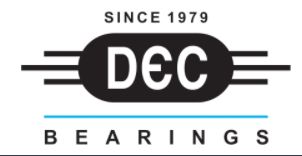1. What is the life of Bearings
Technically, the life of Bearings is determined by the number of rotation number, which varies depending on: load, temperature and working environment. The service life of a bearing in different applications will not be the same.
Theoretically, under ideal conditions when the load is at the allowable threshold, the bearing life will not be limited by the strength of the metal, which may exceed the service life of the machine. However, under actual operating conditions, the life of Bearings is affected by many factors.
2. How to realize when Bearings are about to fail
A bearing that is about to fail usually has the following signs:
-
The bearing housing temperature rises abnormally
-
Unusual noise and hissing noise
-
Vibration was abnormally high
By periodically monitoring the parameters described above, the user can evaluate and predict the working status of Bearings.
3. How to prolong the life of Bearings?
In order to prolong the service life of Bearings, the following should be taken care of:
a. Install and dismantle Bearings properly
When disassembling and installing Bearings, it is necessary to comply with the instructions for usage and specifications given by the manufacturer to avoid mishandling and contaminate the Bearings, which greatly affects to its lifespan.
For installation operations, due to the great precision of the bearing components, great care is required when handling using appropriate tools. Statistics show that 16% of the causes of premature failures of Bearings are incorrect installation, such as: high impact force, unavailable specialized tools and and incorrect methods.
Handling and installation of bearings
Disassembly of the Bearing (Bearing) has 2 purposes: In case of replacement, be very careful not to damage the shaft which greatly affects the life of the new bearing. If a Bearing (Bearing) is removed for maintenance or replacement of other machine parts, the removal tool and method must be appropriate depending on the type, size and type of assembly as the Bearings (Bearings) will be used again.
b. Storage of Bearings
When in original packaging and stored in a clean environment with little dirt, low humidity, no impact or shock, Bearings can be kept for many years. Note that Bearings should not be stored directly on the floor.
For large Bearings, it is recommended to lay them down and support the sides of the inner and outer ring. If placed in a standing position, the weight of the balls can cause local distortion due to the thin-walled rings.
Cleanliness of Bearings is of utmost importance, so they should be kept clean. Contamination and corrosion will result in shortening the service life of any Bearing.
c. Properly lubrication of Bearings
In order for Bearings to bear heavy loads at high speeds, they must be adequately lubricated to avoid direct contact of metal surfaces (creating friction) between balls and cage. The lubricant also limits wear and protects the bearing surface against corrosion.
The actual choice of lubricant depends first and foremost on the operating conditions, such as the working temperature range, speed and other influences. You can select grease, oil or solid lubricants (especially suitable for extreme temperatures).
Over time, the lubricant distributed in Bearings gradually loses its lubricating properties after a period of mechanical work, degenerates and forms impurities. Therefore, if lubricating with grease requires additional or new replacement, for oil lubrication, it must be filtered and replaced periodically to increase the life of Bearings to the highest level.
d. Concentricity of shaft
Loss of shaft concentricity accounts for 50% of the cause of machine failure. Failure of the machine increases downtime, product failure and increasing costs. Incorrect alignment will increase the workload and additional stress on the bearing.
Axial loss of concentricity occurs when the center of rotation of two machine axes is not in the same line. There are usually two types of concentricity (parallel deflection and angular misalignment), and in most cases, concentricity is caused by both.
Loss of shaft concentricity greatly affects the operation of Bearings. Loss of shaft concentricity creates friction, which exerts force on the Bearings of both the actuator and conduction.
e. Monitor of device status
In order to prolong the life of Bearings, it is essential to monitor the machine and Bearings conditions so that damage can be detected early and processed before it occurs. This will not only reduce the possibility of major damage but also allow planning of manpower supplies and repairing plans during downtime.
Important machine condition monitoring parameters to consider include: noise, temperature, speed, vibration, shaft concentricity, lubricating oil and bearing condition.

















